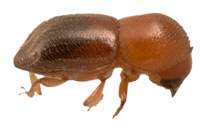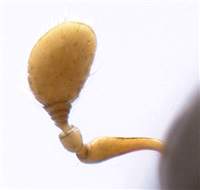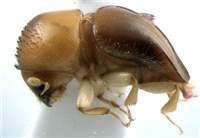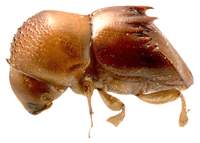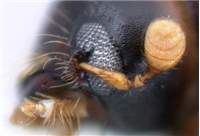Diagnosis
Bulky, light-colored, pronotum mostly yellow. Pronotum usually with two serrations pointing forward on anterior edge, antennal club flat, type 1, protibiae slender.
Elytral disc short, but elytral declivity very long, flat, broad, and laterally carinate. Elytra usually with one or two pairs of denticles on summit.
Similar to Xylosandrus, but procoxae contiguous.
Distribution
Tropical South Asia and Oceania, rare in Africa.
Biology
Many species mycocleptic, taking advantagte of fungal gardens of larger Xyleborini (Hulcr & Cognato, 2010). Browne (1961b) provided brief notes on ecology of several Malaysian species. Species found in all sizes of wood, from dry twigs to humid trunks.
Taxonomy
Nested in clade of species with mesonotal mycangium, but mycangium secondarily lost (probably due to mycocleptism).
Detailed description
Eyes shallowly emarginate, upper part smaller than lower part. Antennal club approximately circular or slightly taller than wide and asymmetrical, always very flat. Antennal club type one (truncated, segment 1 covering posterior side). Segment 1 of club covering entire posterior face, its margin circular, fully costate, mostly or fully visible on anterior side. Segment 2 narrow, pubescent, visible on anterior side only. Segment 3 absent from posterior side of club. Segment 1 of antennal funicle shorter than pedicel, funicle 4-segmented, scapus usually long and slender, in minute species regularly thick. Frons above epistoma smooth, alutaceous, with minor punctures. Submentum flat or slightly impressed, shaped as very narrow triangle. Anterior edge of pronotum with two distinct flat denticles protruding anteriad. Pronotum from lateral view rounded and robust (type 5); exceptions are rare, from dorsal view rounded (type 1). Pronotal disc shining or smoothly alutaceous, with small punctures, lateral edge of pronotum obliquely costate. Procoxae contiguous, prosternal posterocoxal process short and conical, or flat and inconspicuous, or tall and pointed. No sign of mesonotal or elytral mycangial opening. Scutellum flat, flush with elytra. Elytral bases straight, with oblique edge. Elytral disc shorter than or as long as declivity, rarely longer, flat or convex. Punctures on elytral disc in strial lines (which may be difficult to discern). Elytral declivity flat, gradually sloped, never steep, conspicuously broadened and costate along posterolateral edge, edge bearing carina, which ends in 7th interstriae. Each of second and third interstriae often bears a tooth or a pointed hook on summit of declivity. Elytral declivity not conspicuously pubescent, except for small appressed setae in several species. Posterolateral costa ending in 7th interstriae. Striae and interstriae on upper part of declivity flat, or bearing teeth around declivity. First interstriae parallel. Protibiae sometimes obliquely triangular, broadest at 2/3 of length, but mostly very slender, slightly broader only at distal end. Posterior side of protibia flat, no granules, only setae. Protibial denticles large, distinctly longer than wide, bases of denticles slightly elevated to distinctly enlarged and conical, fewer than 6 protibial denticles present. Uniformly yellow, orange, light brown or reddish, pronotum often much lighter (yellow or orange) than elytra; montane forms typically black. Length: 1.4-3 mm.


